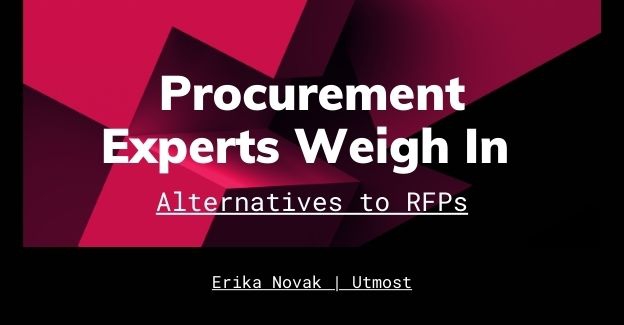The RFP process is largely broken, says Erika Novak, Head of Client Services at Utmost. She offers three ways your organization can take advantage of innovation and speed to market, which can rarely be achieved because standardized RFP processes take months to complete.
In enterprise software and services, procurement’s use of a Request for Proposal (RFP) is meant to compare competitive product offerings against a set of requirements. The intent was to create an environment where vendors could respond with functionality, price, implementation details and unique offerings. Unfortunately, the RFP process has largely failed for several reasons. Today, the focus is on innovation and speed to market, which can rarely be achieved in a standardized RFP process that can take months to complete.
In a recent webinar, “Innovation in Procurement: Alternatives to Traditional Practices,” I spoke with three procurement executives – Dean Edwards (Kaiser Permanente, Yahoo, Levi's); Paul Campbell (Hewlett Packard, Phillips, Schneider Electric, BA); and Roger Jellicoe (Motorola, Intel) – about the work they’ve done consulting procurement executives that want to capitalize on innovation. Part of our discussion centered around how organizations reframe the traditional RFP, how they can “fail faster,” and how to capitalize on cutting-edge technologies.
Innovation can relate to products, services, processes, compensation methodologies and new ways of thinking. Our discussion centered around products, services, business models and ways procurement organizations are working today. As with many groups, processes that are disruptive and get a lot of resistance, both structurally and culturally, tend to get pushback. But to foster and accelerate growth, procurement has an important role in helping to accelerate innovation through new ways of vetting and comparing tech vendors.
Procurement has traditionally been looked at as the cost savings mechanism in organizations, but costs are not necessarily being able to reduce pennies and dollars off of what's procured. “Mature procurement organizations are focused on accelerating time to market for products, new businesses and new business models, because the faster you're generating revenue, the faster you're generating return on those investments,” Paul commented.
When it comes to traditional RFPs, this often means doing away with them altogether. “If you're not getting the scorn and ridicule of your colleagues, you're not pushing the boundaries far enough,” Roger added. This doesn’t mean you throw process out the window, but that you infuse enough innovation into it that you’re constantly challenging the status quo. “Process, it's damaging when it's overused. One of the keys to innovation is recognizing when an exception to a widely used process is going to be helpful rather than hurtful.”
So, how can your organization take advantage of a certain amount of rigor without missing out on innovation, time to revenue and risking cost (growth vs. loss)? Here are a few considerations to think about.
Are the right people involved in change management?
To make a big change within an organization used to running traditional RFPs, you’ll want to ensure the entire process is owned by someone who can ultimately pull the trigger on bringing in a new technology or software. “Many in procurement have had to figure out that a 40-page contract and a vendor evaluation process is not the right way to work with the startups, the companies that any innovation team or R&D team are bringing in,” Paul said. “The procurement team that specifically supports innovation should be running the evaluation process, not just a standard procurement manager.”
This person or group must be able to quickly figure out what the opportunity cost of a four-month RFP process would be to the business and be able to articulate that loss to the business.
Are you asking the right questions?
Often, companies have a lot of bureaucracy that supports their core business and subscribe to the “this is how we do it because we’ve always done it this way” mentality. When it comes to teams that are now saying, “We want to create a new business model and a new go-to-market process,” traditional functions that support procurement like finance, legal, supply chain and risk don't know what to do, so they pull out their SOPs and manuals and attempt to remain status quo.
The key is asking the right questions upfront like, “How did we decide this was the ‘right’ process?” By slowly dismantling or deconstructing the original approach, Roger said, organizations can find out the reason, motivation and goals. This helps target how the company is motivated, how they're approaching things, and what can be shifted. “You kind of deconstruct their approach, their mindset, their processes, and you reconstruct it in a new way,” Paul said. “You focused on this new opportunity and the new business model that's needed to support that.”
Are you engaging the right people in a new process?
By proactively engaging the supporting functions of the business, there is much to be learned about formulating a new approach. The more business lines feel a part of the solution, the more likely they will champion a new process. These business lines are designed to support functions like procurement, so use their expertise to your advantage.
Additionally, there needs to be a discussion with business lines that traditionally circumvent RFP processes for the reasons noted above. While they may be trying to achieve that speed-to-market, they may be costing the organization in other areas, so understanding that rationale is important when building out a new process for evaluating vendors.









